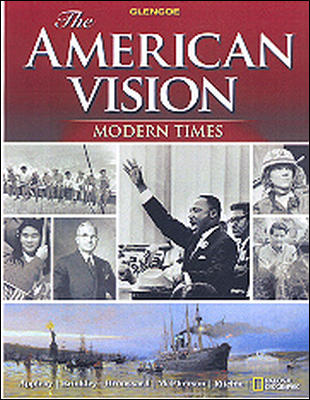
The American Vision Modern Times © 2010Chapter 14: America and World War II, 1941-1945Chapter OverviewsThis chapter details American involvement in World War II, tracing the initial mobilization on the home front, the battle campaigns overseas, and the events that brought the war to a close. Section 1 discusses how the United States mobilized its economy and armed forces to fight World War II. Even before the attack on Pearl Harbor, President Roosevelt had begun mobilizing the economy. Economic incentives motivated factories to convert to wartime production, while government boards made sure that industrial production met military requirements. Automobile factories began turning out tanks, rifles, and even B-24 bombers, while shipyards churned out Liberty ships. To build up the nation's armed forces, Congress passed the Selective Service and Training Act. Thousands of draftees were hurried through training and rushed onto the battlefields. African Americans and women gained expanded roles in the armed forces. Although segregated at first, the military slowly became more integrated during the war. Section 2 describes the early military campaigns. Japan seized control of the Philippines in 1942 and set its sights on Midway—the last American base in the North Pacific west of Hawaii. Americans turned the tide in the Pacific, however, after they intercepted and decoded Japanese messages. With advance warning of planned attacks, American forces won two important victories and stopped the Japanese advance in the Pacific. In the Atlantic, new technologies helped the Allies detect and sink German subs. In Europe, Soviet troops fought desperately to hold back the German advance in the East, while American and British troops attacked Germans in North Africa. When Hitler launched an attack on the Soviets at Stalingrad, Soviet troops held their ground. The Battle of Stalingrad proved to be a turning point as the war slowly started turning in favor of the Allies. Section 3 focuses on the challenges Americans faced on the home front during World War II. As millions left the civilian workforce to join the military, employers faced labor shortages. New faces began showing up in the workplace as employers hired women and minorities for jobs previously reserved for white males. The president stepped up to ensure these new workers would receive equal treatment in the defense industry and federal government. As workers migrated to fill vacant positions, African Americans living in the South resumed their migration to the already crowded cities of the North and West. Racial prejudice that targeted African Americans and Mexican youth sometimes erupted into violence. The federal government ordered the internment of all people of Japanese ancestry. Wartime stresses affected nearly every American as inflation, rationing, victory gardens, and war bonds became a part of the social fabric of the war years. Section 4 describes how the Allies slowly pushed back the German and Japanese forces in 1943 and 1944. As the Allies stepped up the bombing of Germany, they pushed forward with an invasion of the island of Sicily. The capture of Sicily was the first step in an Italian campaign that lasted over two years and proved to be one of the bloodiest of the war. In the spring of 1944, Allied forces prepared for Operation Overlord—the invasion of German-held France. On D-Day, Allied ships, soldiers, paratroopers, and fighter-bombers launched the invasion at the beaches of Normandy. While Americans suffered heavy casualties at Omaha Beach, the invasion succeeded and troops moved inland. In the Pacific, the Americans used a two-prong attack to defeat Japan. The Pacific fleet island-hopped from one island to the next, making its way to Japan, while troops in the Southwest Pacific retook the Philippines. Section 5 traces the events that finally led to end of World War II. In the summer of 1944, American and British forces broke out of Normandy, liberated Paris, and started toward Germany's western border. Meanwhile, the Soviet army successfully drove Hitler's forces out of Russia and began closing in from the east. Crumbling Nazi defenses forced the unconditional surrender of Germany on May 7, 1945. The Allied forces were now able to focus exclusively on the war in the Pacific. In two tortuous invasions, Americans captured the Japanese islands of Iwo Jima and Okinawa. After American firebombing of Japan's industrial cities failed to convince the Japanese to surrender, the United States prepared to use a new weapon. Atomic bombs dropped on Hiroshima and then Nagasaki finally forced Japan's surrender on August 15, 1945. While Nazi and Japanese military leaders went on trial for war crimes, world leaders hoped that a new international political organization would prevent another world war from ever happening again. |  |















